Widely acclaimed as a food heaven, Singapore is a country of dead-serious eaters who care deeply about what they eat. As a multicultural country, Singapore incorporates its rich heritage into its food, so much so that its cuisine cannot be exactly defined.
Predominantly a blend of Malay, Chinese and Western influences (and basically food hailed from just about everywhere), the local Singapore cuisine is instead defined by what is borrowed, and how it all assembles harmoniously to form an entirely unique puzzle of cuisine.
This list is not at all comprehensive, as there are undoubtedly many more foods that are equally delicious and significant to many. But one thing that I am sure of is that the best meals that this city has to offer are also the cheapest meals served, not by big name chefs in fancy restaurants with expensive ingredients, but in hawker centers (large open-air complexes housing rows of cluttered food stalls) with the most simple ingredients.
It is thus only in a place where eating has become a way of life that there exists some kind of culinary magic that creates big flavors from humble ingredients, and that people find maximum satisfaction from the perfection in flavors and textures exuded in just a simple plate of noodles or rice with some side dishes.
1. Chai Tow Kway at Fu Ming Cooked Food
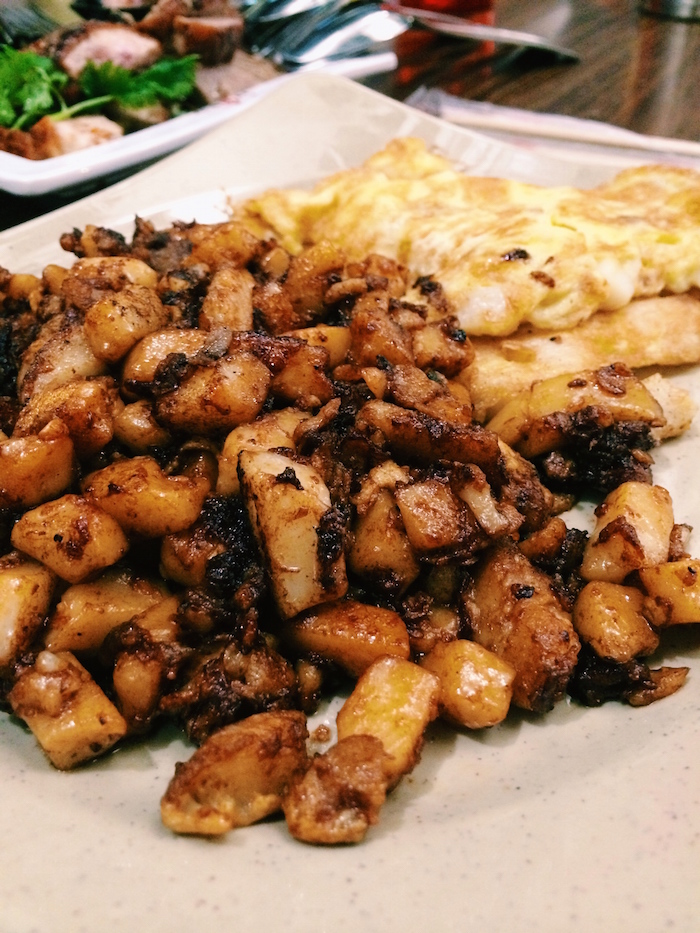
Photo by Elisa Djuhar
Known also as “carrot cake” in English (no, not the American dessert), this is a stir-fry dish made up of chopped up radish cake, eggs, preserved radish, and seasonings. There are two versions: a lightly seasoned “white” version, and a “black” version that is drowned in a generous serving of thick soy sauce.
2. Kaya Toast, Soft Boiled Eggs and Kopi at Ya Kun Kaya Toast
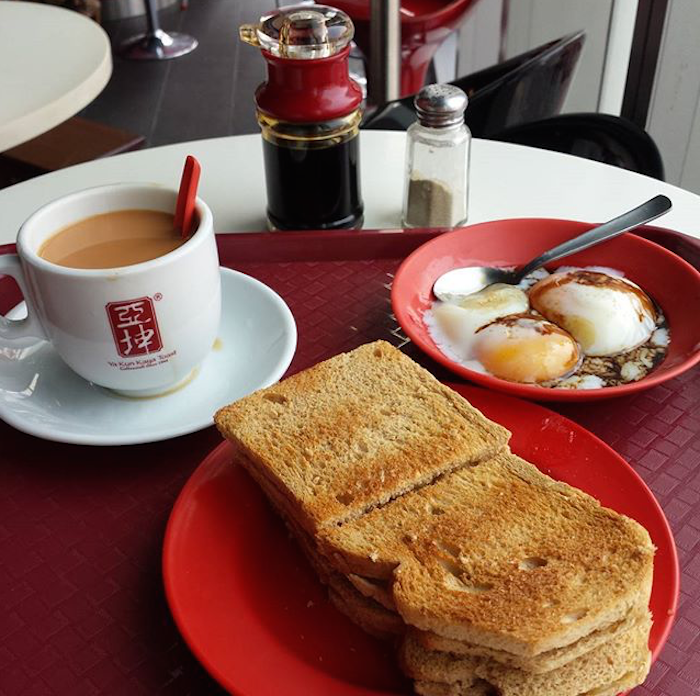
Photo by Elisa Djuhar
This is the one and only traditional Singaporean breakfast that has stood the test of time and is still extremely popular among Singaporeans of all ages.
Traditionally, the bread is an old-school white loaf that has been grilled over a charcoal fire till golden brown and crispy, halved into two thinner pieces, and then slathered with kaya (coconut jam) and a thick slice of cold butter.
The soft-boiled eggs are usually seasoned with pepper, drizzled with a dark soy sauce and then mixed together to create this dark-colored concoction with bits of white and yellow color that is as luscious and indulgent as it gets. The local kopi (the Malay term for “coffee”), made with Robusta beans and usually served with condensed milk, is full-bodied and aromatic with a tinge of acidity and pepper spice.
3. Chwee Kueh at Jian Bo Shui Kweh
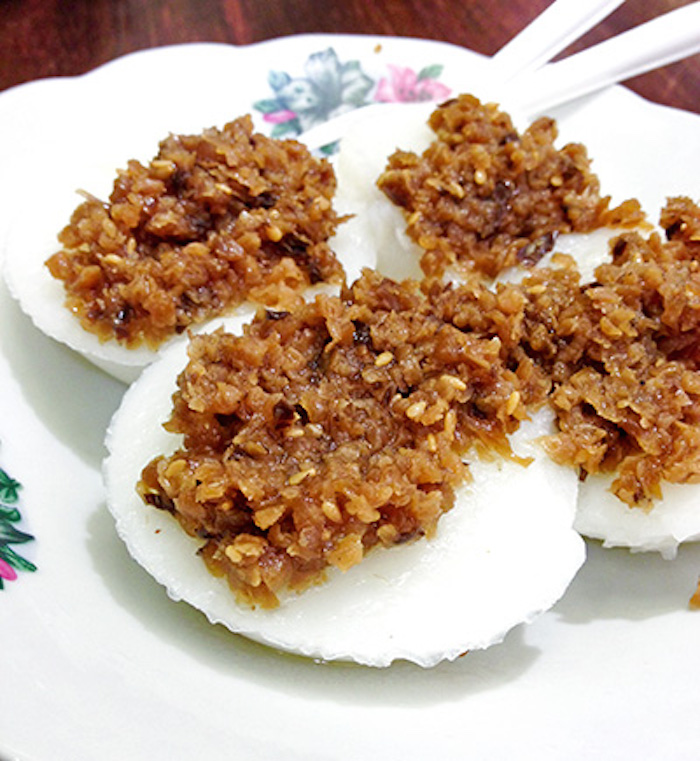
Photo courtesy of aromacookery.com
Chwee kueh is another nostalgic breakfast dish among many Singaporeans. A steamed rice cake is made with rice flour and water and then generously topped with umami-rich chye poh (preserved radish) and mild chili sauce. These are wobbly, soft and a little chewy with just a slight bite.
4. Oyster Omelet at Ah Hock Fried Oyster Hougang
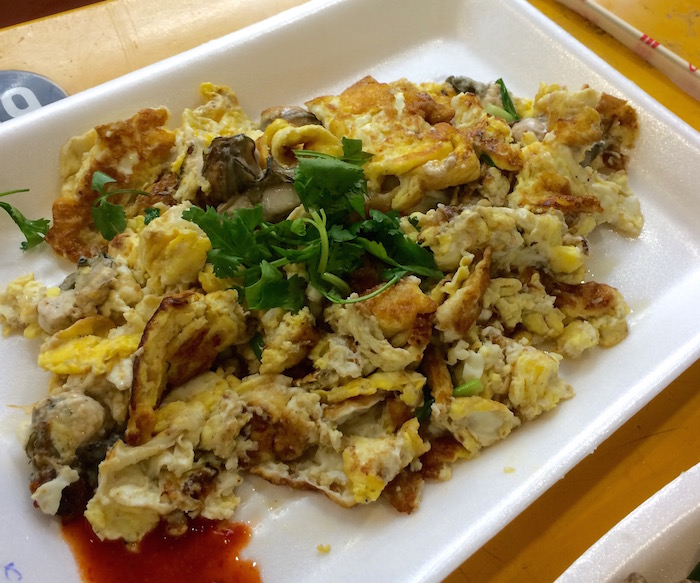
Photo by Elisa Djuhar
Oyster omelet is basically an omelet that has the additional ingredients of starch and oysters. The result is a mixture of fried eggs and juicy, delectable oysters with a crisp, crusty exterior and soft, custardy insides. All the better if eaten together with chili.
5. Rojak at Toa Payoh Rojak
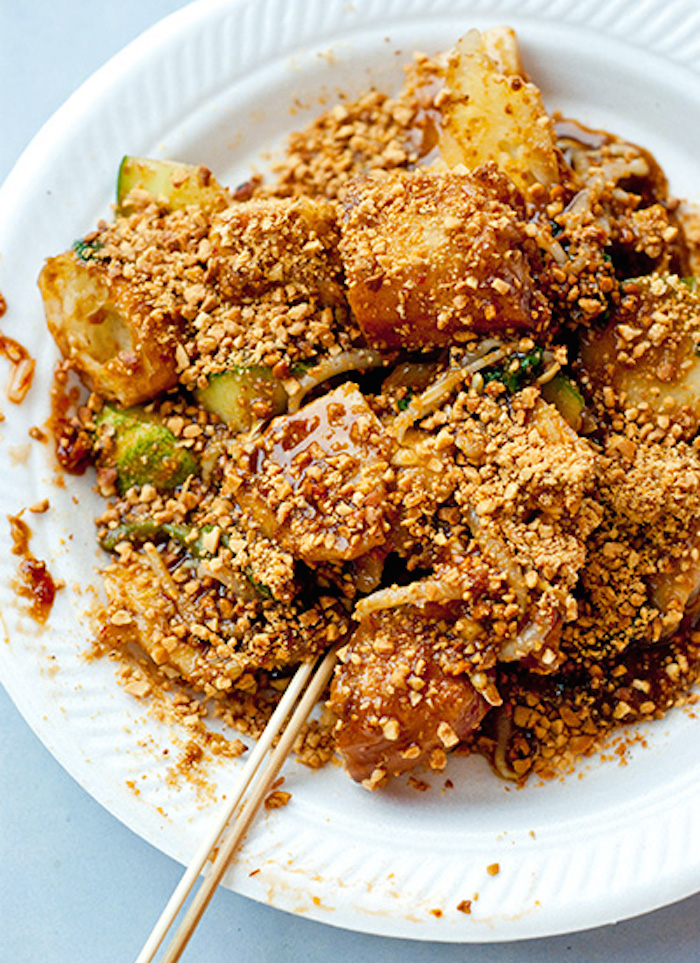
Photo courtesy of aromacookery.com
Rojak is basically a fruit and vegetable salad, drenched in a sweet dressing made of shrimp paste, sugar and lime juice, topped with a dusting of ground peanuts. While common ingredients include green apple, green mango, pineapple, jicama, cucumber, radish and you tiao (fried dough fritters), it is also entirely customizable according to your liking.
6. Satay at Haron 30 Satay
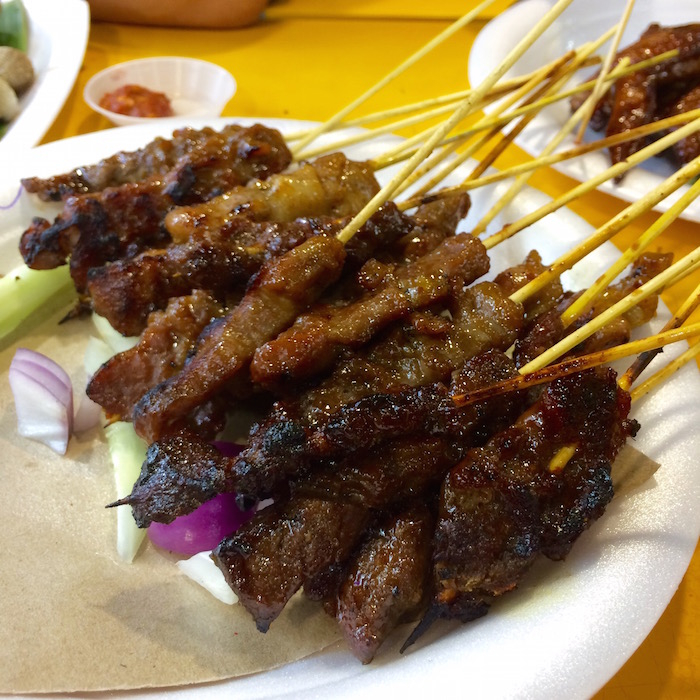
Photo by Elisa Djuhar
Satay is a dish of bamboo-skewered, marinated meat that is grilled over a charcoal fire. Although it originated in Indonesia, satay has become a mainstay of Singapore’s hawker fare. Typical meats include chicken, beef and even mutton or pork. It is served with ketupat (rice cake), onions, cucumbers and a slightly sweet, spicy peanut sauce.
7. Roti Prata at Sin Ming Roti Prata
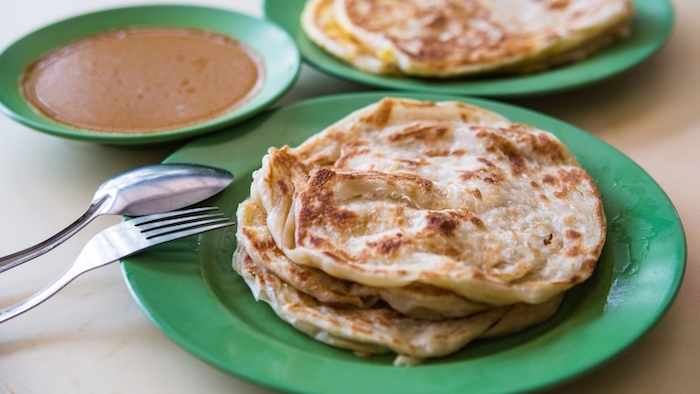
Photo courtesy of thesmartlocal.com
Roti prata is of Indian origin, has a Malay name, and is eaten by everyone including the Chinese—it encompasses and reflects Singapore’s unique feature of racial harmony. It is a kind of flatbread that is crisp and flaky on the outside and soft and chewy on the inside. The dough is first stretched skillfully by hand until paper-thin, folded inwards multiple times, and then griddled in ghee (clarified butter) or oil. It is traditionally eaten with curry.
8. Popiah at Qi Ji

Photo courtesy of qiji.com.sg
With a skin so thin and translucent, and fillings such as prawns, eggs, bean sprouts, turnips, and peanuts, popiah is more commonly eaten as a side dish than as a whole meal by itself. It is also served with sweet hoisin sauce and the ubiquitous Singapore chili.
9. Bak Kut Teh at Song Fa Bak Kut Teh
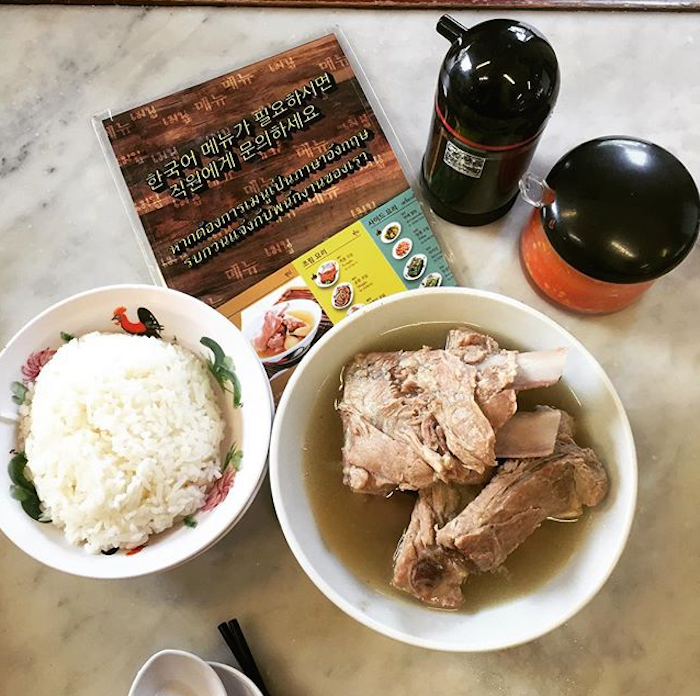
Photo by Elisa Djuhar
Bak kut teh literally translates to “pork bone tea.” Made with pork ribs that have been simmered with herbs, bak kut teh is the chicken noodle soup of Singapore. This dish has been in Singapore ever since its humble beginnings as a small fishing village and was traditionally drunk in the morning for an efficient energy boost.
10. BBQ Chicken Wing at Huat Huat BBQ Chicken Wings
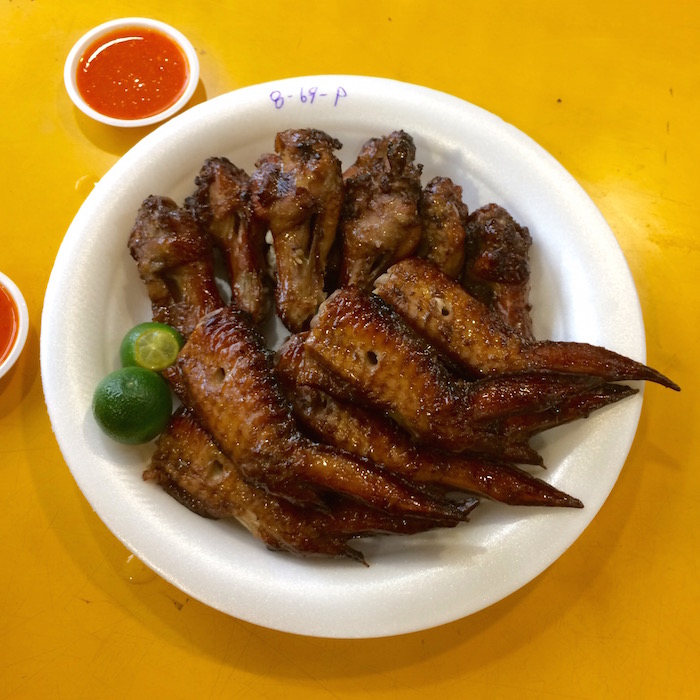
Photo by Elisa Djuhar
Many cuisines have their own version of chicken wings, but Singapore’s BBQ chicken wings are all about the marinade and the barbecue. Grilled over a stingingly hot open charcoal fire (on skewers carefully managed by hand), the wings are evenly bronzed and have an incredibly smoky flavor. The skin is simultaneously crispy yet chewy, and the meat inside is succulent and tender.
11. Curry Puff at Rolina
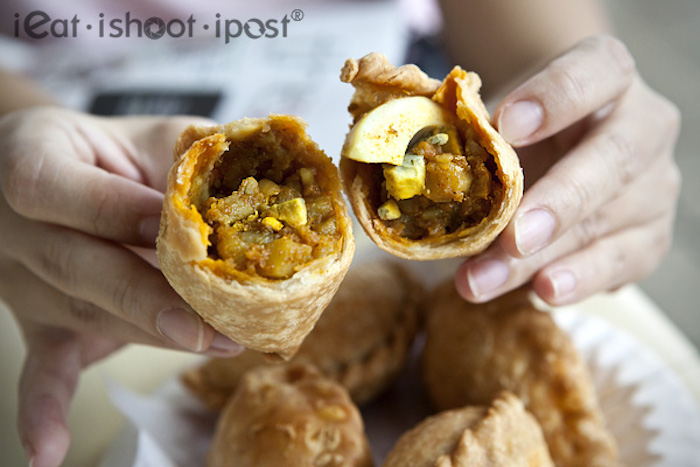
Photo courtesy of ieatishootipost.sg
Either baked or fried, curry puff is basically a small baked pie filled with some kind of poultry, potato, egg and curry gravy. At Rolina, you will be guaranteed a curry puff with an extremely flaky pastry and substantial fillings.
12. Dim Sum at Swee Choon

Photo by Elisa Djuhar
Granted, dim sum isn’t originally Singaporean; it’s a meal inspired by Hong Kong, Shanghai and other parts of China. But because Singapore has an ethnic Chinese majority population, it is not surprising that there are many places serving deliciously addictive dim sum.
13. Bak Kwa at Kim Hwa Guan
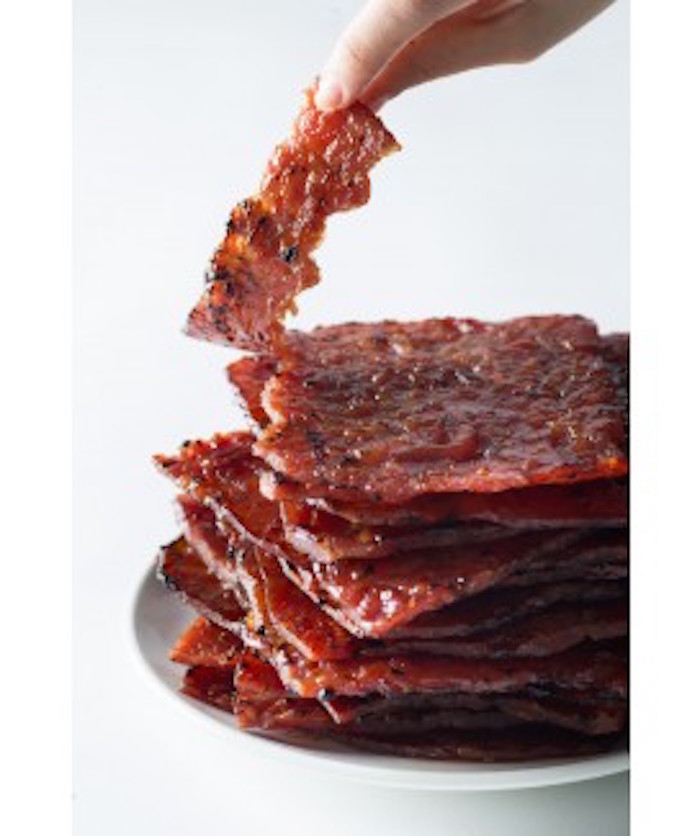
Photo courtesy of beechenghiang.com.sg
Bak kwa is a wafer-thin slice of dried barbecued pork jerky. The pork, marinated in a sweet and savory sauce, is grilled over a charcoal fire till aromatic and caramelized. At Kim Hwa Guan, every glistening piece is pleasantly juicy and tender with a slight bite and a sweet and savory taste that lingers on the palate.
14. Chicken Rice at Tian Tian Chicken Rice
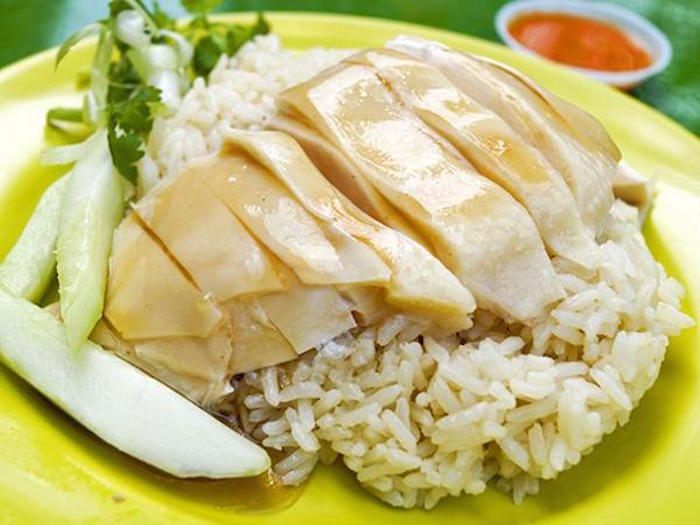
Photo courtesy of aromacookery.com
Chicken rice is one of the most celebrated dishes here in Singapore, and no local restaurant, food court or hawker center would be complete without a chicken rice stall. It is really a dish made of more than just steamed chicken and rice.
Usually, the chicken is stuffed with garlic cloves, ginger and green onions, and then poached gently in water. The chicken is then dunked in ice-cold water to create a layer of luscious melt-in-your-mouth jelly just beneath the chicken’s skin. In this “white” version, the chicken is cooked very lightly and is pink beside the bones. Most stalls also do a “black” version that is roasted to give a crispy brown skin in contrast to the tender, succulent meat.
The rice, cooked in chicken stock, ginger, garlic, soy sauce and a few pandan leaves, is resultantly much more fluffy, flavorful, fragrant (and, of course, sinful) than ordinary white rice. Another equally important component that makes certain stalls stand out is the quality of their dipping sauce, chili sauce and ginger sauce.
15. Duck Rice at Soon Kee Long House Boneless Duck Rice
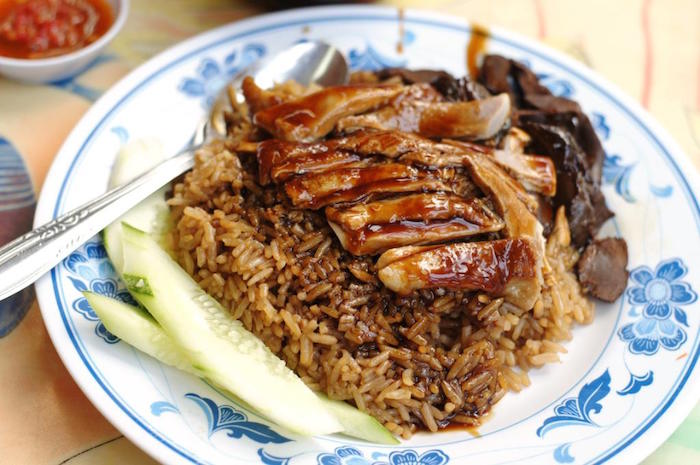
Photo by Elisa Djuhar
Duck rice is one of the popular staple foods in Singapore. Braised together with herbs and spices, the sliced duck meat is tender, moist and succulent. It is often accompanied with either white rice or braised yam rice, crispy tau pok, and hard-boiled eggs and peanuts, all drizzled with a thick, dark, slightly sweet gravy.
16. Nasi Lemak at International Muslim Food Stall
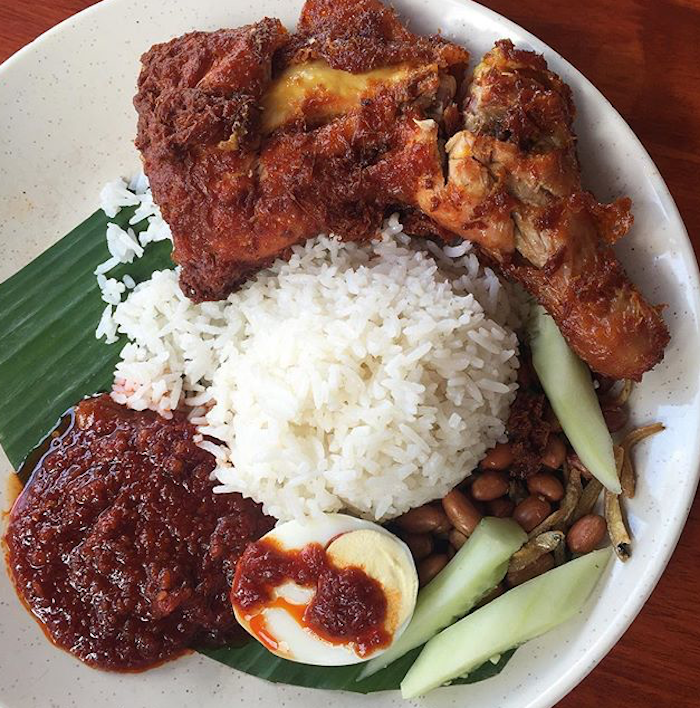
Photo by Elisa Djuhar
Nasi lemak is a deeply-rooted Malay dish that started out as an affordable meal for everyday people to fill up their stomachs. Traditionally, rice is soaked in coconut milk, wrapped in banana leaves and then steamed, resulting in a distinctive flavor and fragrance. It is typically accompanied by ikan bilis (small fried anchovies), peanuts, egg, an additional protein such as chicken or fried fish, and a hot and spicy sauce known as sambal.
17. Frog Porridge at G7 Sinma Live Bull Frog Porridge
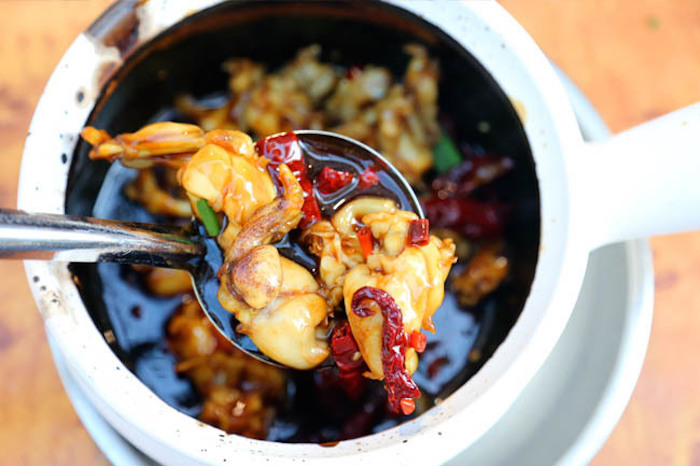
Photo courtesy of danielfooddiary.com
Yes, I’m not kidding. Frog.
But rest assured: this dish can’t get any more comforting and satisfying. Cooked in a clay pot with chili, ginger, spring onions and a liberal amount of oyster sauce, the frog is mouth-wateringly tender — its texture is similar to that of a chicken — and the resulting kung pao sauce is packed full of flavor.
18. Nasi Briyani at Bismillah Briyani
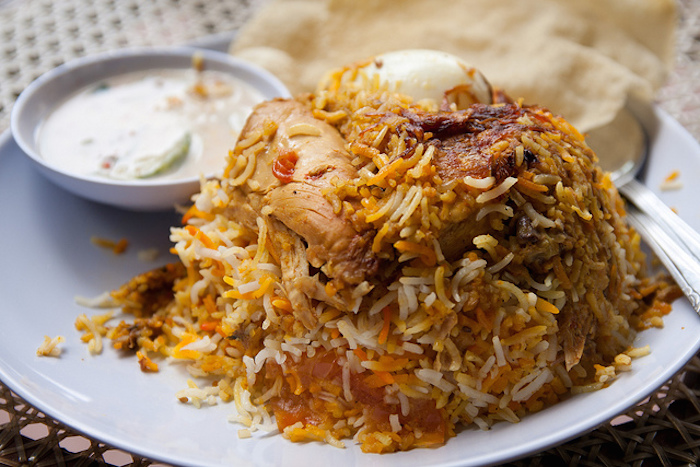
Photo by Elisa Djuhar
Nasi briyani is another Singaporean dish of Indian origin with distinct Malay influence. The key to a great nasi briyani is the basmati rice, one of the world’s most expensive varieties. At Bismillah Briyani, the marinated mutton and rice are cooked the old-fashioned way in a pot over a charcoal fire. Served with thick, spicy curry, and sometimes even raisins and cashews, nasi briyani is indeed quite a hearty, substantial dish.
19. Claypot Rice at Geylang Claypot Rice
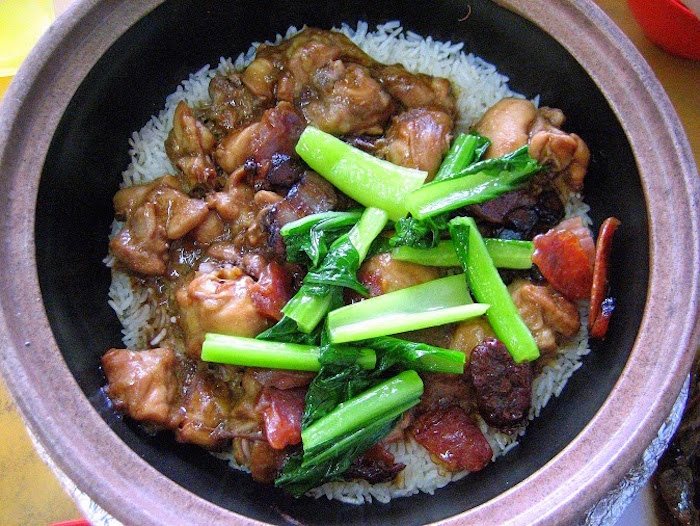
Photo courtesy of thehungrybunnie.com.sg
Personally, I think the beauty of eating clay pot rice lies in the slightly burnt (but crispy) bits of rice stuck on the sides of the clay pot. When eaten together with a myriad of ingredients including succulent chicken, Chinese waxed sausages, and fragrant bits of salted fish and vegetables, clay pot rice is truly an excellent, hearty dish that you cannot miss in Singapore.
20. Nasi Padang at Hajjah Mona Nasi Paddang
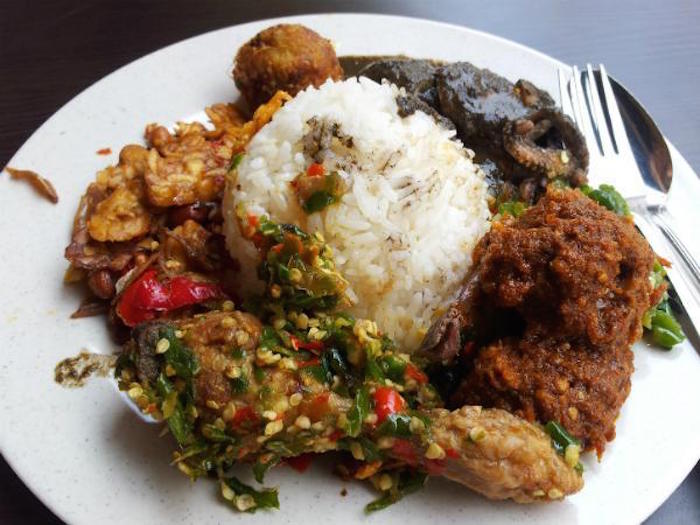
Photo courtesy of hungrygowhere.com
Nasi padang originated from Padang, the capital of West Sumatra, Indonesia. It isn’t exactly a particular dish, rather, it is a plate of steamed white rice served with an array of meat and vegetables that have been cooked with robust spices. Like the original stalls in Padang, the accompanying dishes are displayed neatly behind a glass counter and customers point to the dishes that they wish to savor.
21. Laksa at 328 Katong Laksa
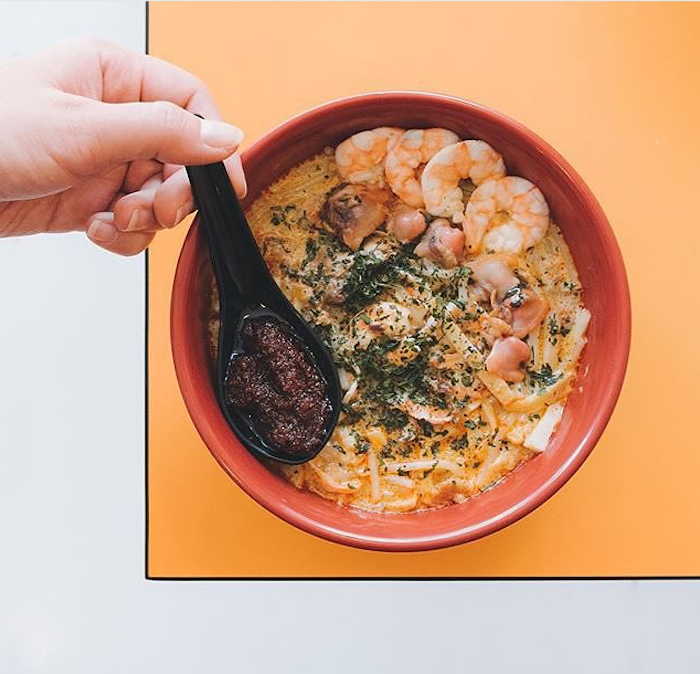
Photo by Elisa Djuhar
Made with coconut milk, chicken stock and dried shrimp paste, the laksa broth (or what locals call zhap) is both creamy and rich in flavor and fragrance. Traditionally, in addition to rice vermicelli noodles, fishcake slices, prawns, tau pok (bean curd puff), bean sprouts and laksa leaves, a spicier sambal belacan is added as well. Singaporeans evidently can’t get enough of that heat, can they?
One of the most well-known varieties here is the 328 Katong Laksa, which beat Gordon Ramsay at the SingTel Hawker Heroes Challenge two years ago. A unique characteristic of this version is that the vermicelli noodles are cut into shorter strands and only require a spoon to eat.
22. Prawn Mee Noodle Soup at Noo Cheng Adam Road Prawn Mee
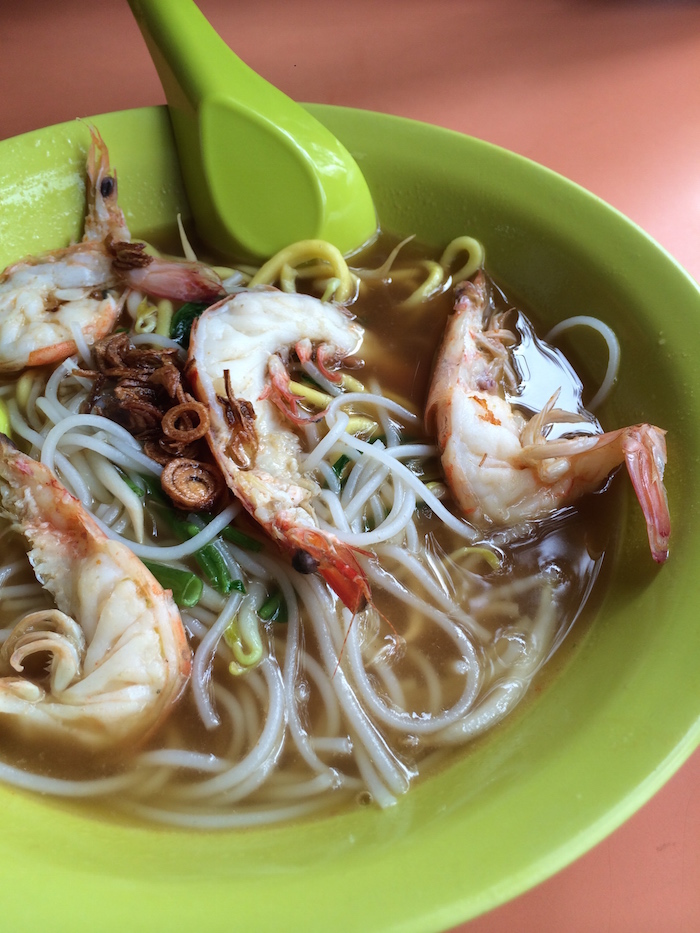
Photo by Elisa Djuhar
Like the laksa, the true test of a good prawn mee noodle soup is its broth. Both pork bones and prawn shells are boiled long and slow, resulting in an unctuous broth that is sweet, earthy and umami-rich. Traditionally, yellow noodles are used, but the choice is entirely up to you. Of course, fresh, succulent jumbo prawns are always welcome.
23. Wanton Mee at Fei Fei Wanton Mee
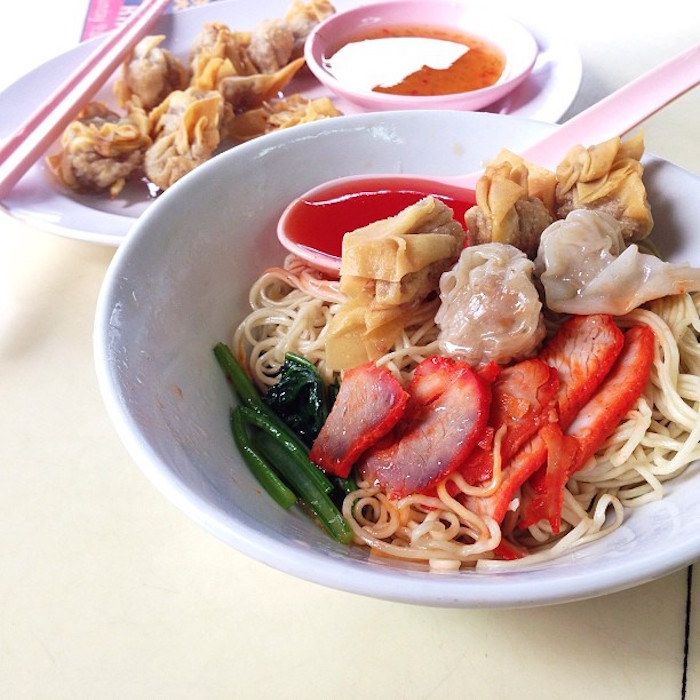
Photo by Elisa Djuhar
The Singapore version of wanton mee is typically eaten “dry,” meaning springy noodles are dressed with hoisin sauce, light soy sauce and fragrant oil, served with slices of char siew and wonton dumplings filled with pork with a small bowl of soup on the side.
24. Bak Chor Mee at Kim Bak Chor Mee
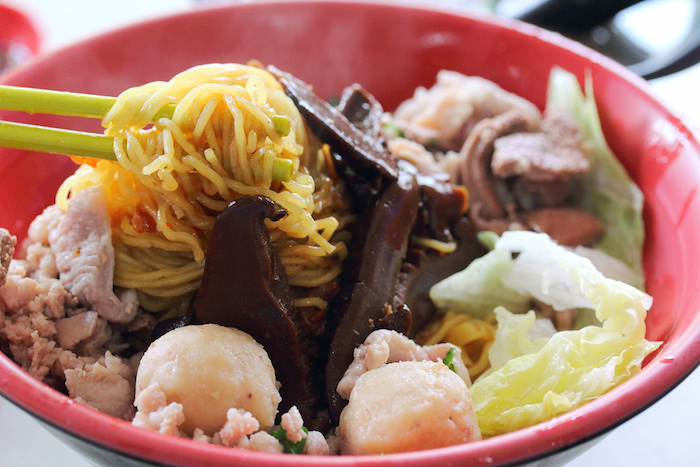
Photo courtesy of sgfoodonfoot.com
Bak chor mee, also known as minced meat noodle, is a unique dish that utilizes various parts of the pig. From pork bones for the broth to minced pork, pork liver, lean pork slices and pork meatballs for toppings (and even pork lard to coat the noodles), this dish represents Singaporeans’ love for pork.
All this is great, but even better when paired with thickly sliced vinegar-braised mushrooms. Of course, there’s always a side of a specially-made chili if you so wish.
25. Hokkien Prawn Mee at Nam Sing Hokkien Fried Mee
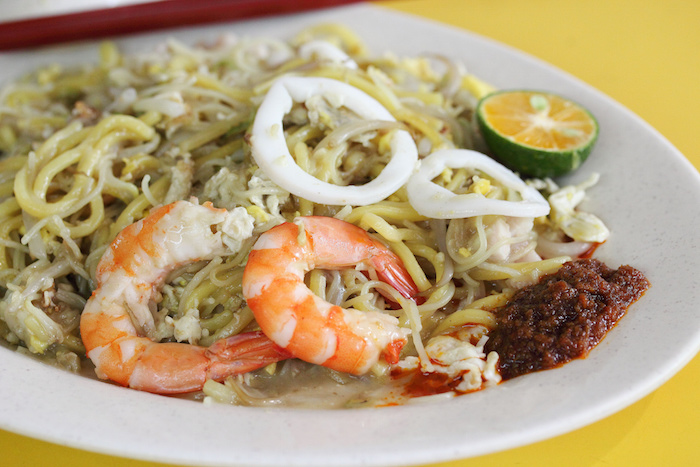
Photo courtesy of sgfoodonfoot.com
This dish is all about the combination of egg and rice noodles, and a hearty emulsified sauce of rich prawn stock and pork lard. It’s stir-fried together in a wok with ingredients such as prawns, cockles, squid and bean sprouts, so the smoky flavor of the wok shines through in each mouthful.
26. Char Kway Teow at Hill Street Char Kway Teow
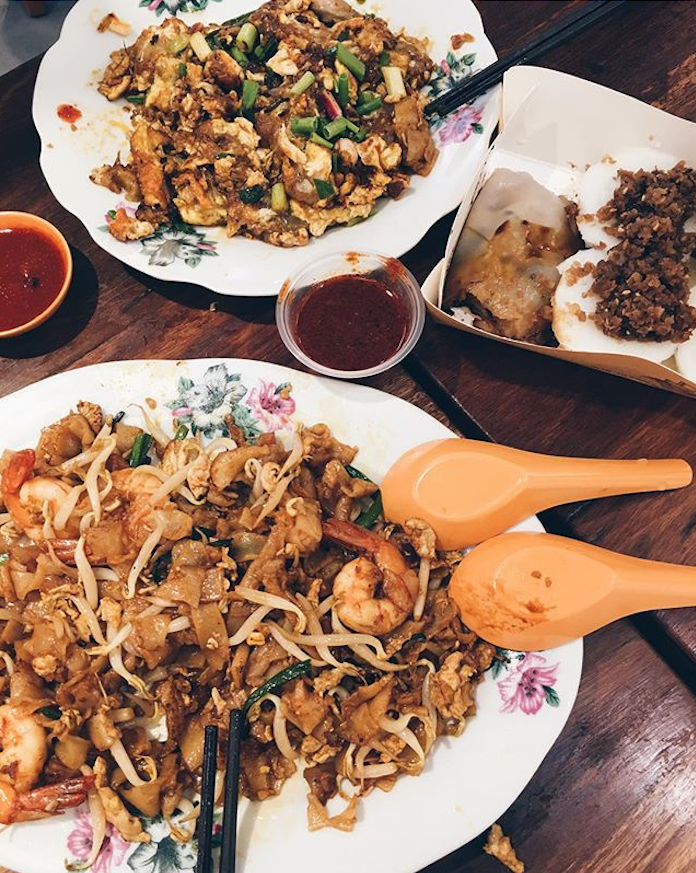
Photo by Elisa Djuhar
Perhaps the king of all noodle dishes in Singapore, char tway Teow is a smoky stir-fry dish consisting of flat rice noodles, egg, pork lard, Chinese sausages, shrimp and bean sprouts all coated in a sweet, dark sauce.
27. Fishball Noodle at Yong Hua Handmade Fishball Noodle
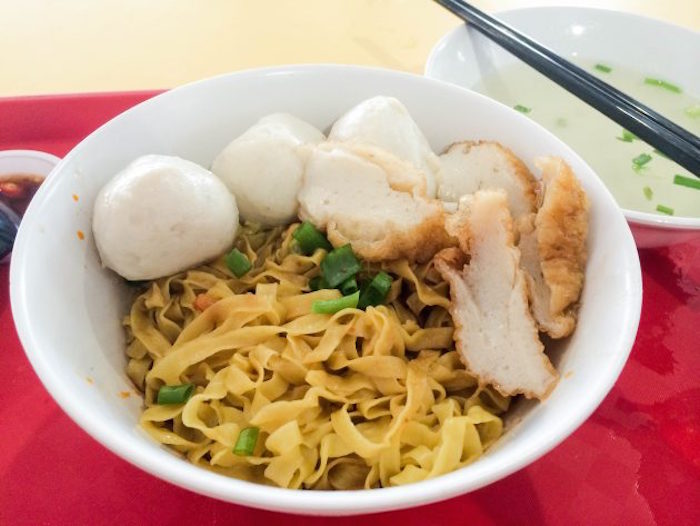
Photo courtesy of thesmartlocal.com
Here at Yong Hua Handmade Fishball Noodle, the savory fish broth has the right amount of umami, salty flavor, and both the fishballs and fish cakes are juicy and tender, with just a slight bite. It’s quite unassuming, yet extremely comforting and definitely one of the best dishes to get on a cold, rainy day.
28. Mee Siam at Wak Limah Stall
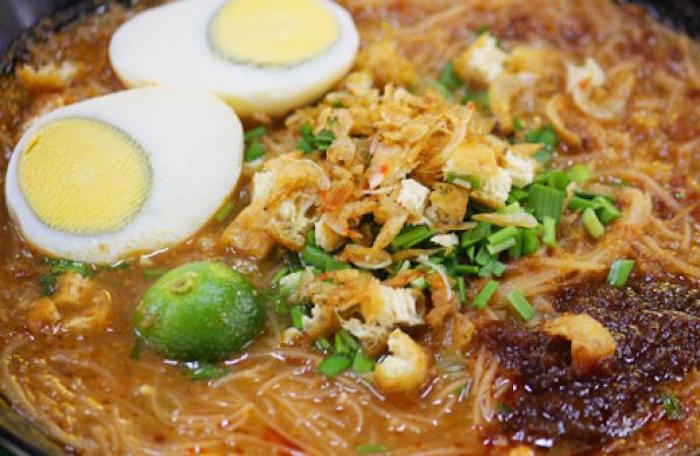
Photo courtesy of soshiok.com
A bowl of mee siam consists of vermicelli noodles, hard-boiled egg, bean sprouts, and tau pok drenched in a sweet, sour, spicy gravy made of tamarind, dried shrimp paste and fermented soybeans. Garnished with chives, it is a dish that successfully balances every single flavor.
29. Mee Rebus at Rahim Muslim Food
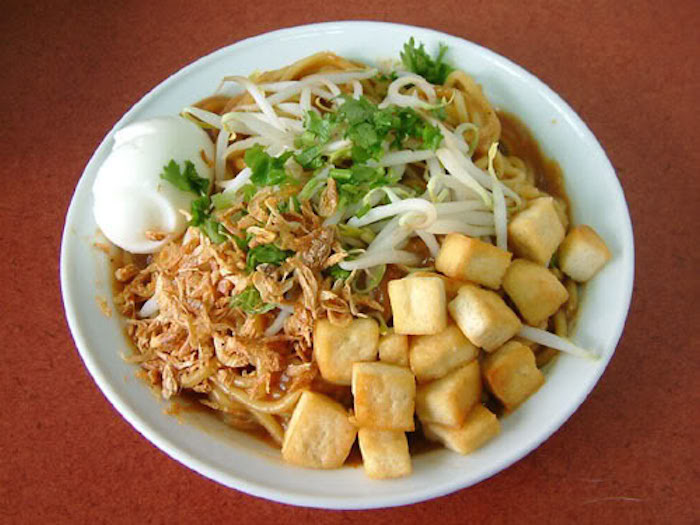
Photo courtesy of jiaksimi.blogspot.sg
Like the hokkien prawn mee, mee rebus consists of egg yellow noodles. Its curry-like gravy, made of potatoes, curry powder, peanuts, dried shrimp paste and fermented soy beans, is comparatively thicker, slightly sweeter, and less sour than that of the mee siam.
30. Mee Goreng at Hass Bawa Mee Stall
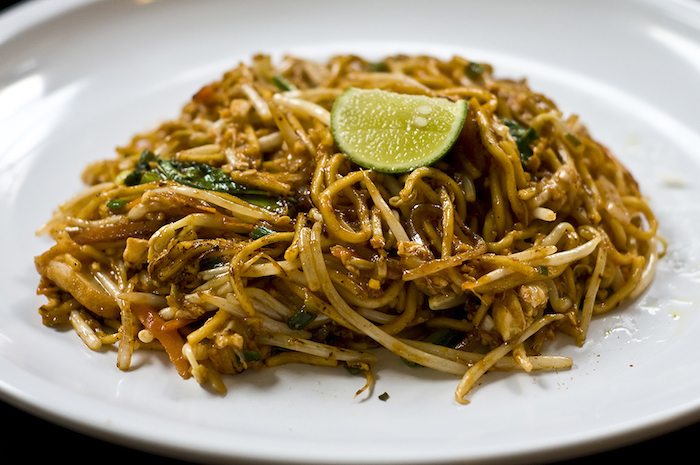
Photo courtesy of nigellow.wordpress.com
Mee goreng is a flavorful stir-fry dish of yellow noodles and other ingredients such as sliced cabbage, shrimp and tofu. Its sauce is distinctively sweet due to the addition of sweet soy sauce. A carbohydrate-laden dish, this is sure to satisfy all types of cravings and moods.
31. Lor Mee at Feng Zhen Lor Mee
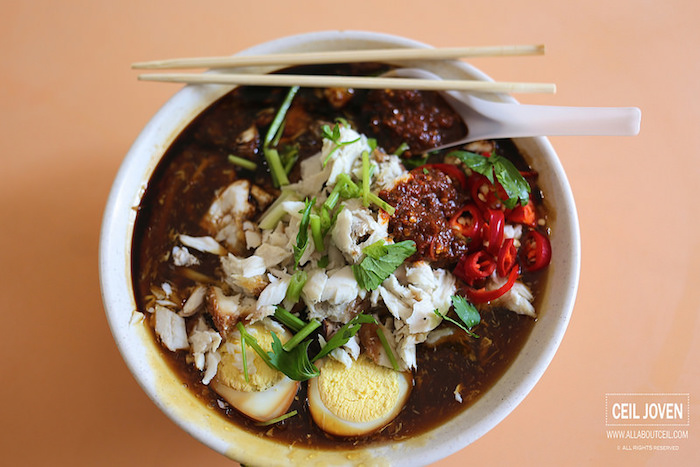
Photo courtesy of allaboutceil.com
Lor mee is a braised noodle dish served in a bowl of gravy that is described to be simply mucilaginous, due to thickening agents of both starch and egg. It is often accompanied with braised pork, hard-boiled egg and fish cake, among other ingredients. Another unique characteristic of lor mee is the addition of minced garlic and black vinegar before serving.
32. Sliced Fish Bee Hoon at Holland Village XO Fish Head Bee Hoon Restaurant
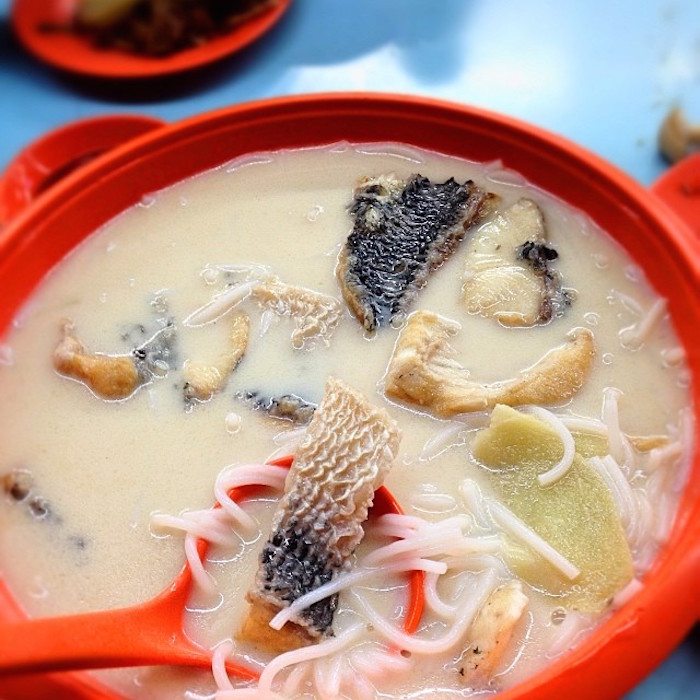
Photo by Elisa Djuhar
The broth is made from either fish or pork bones that have been boiled for several hours. Here at Holland Village XO Fish Head Bee Hoon Restaurant, although the milky broth looks seemingly unappetizing, it stands out for its flavor due to the generous infusion of XO brandy into the broth.
The resulting broth, balanced with ginger, is deliciously rich, flavorful and absent of fishiness. As the thick rice vermicelli noodles soak up the creamy broth, every mouthful is guaranteed to be a gastronomic bliss.
33. Yong Tau Foo at Xiu Ji Ikan Bilis Yong Tau Foo
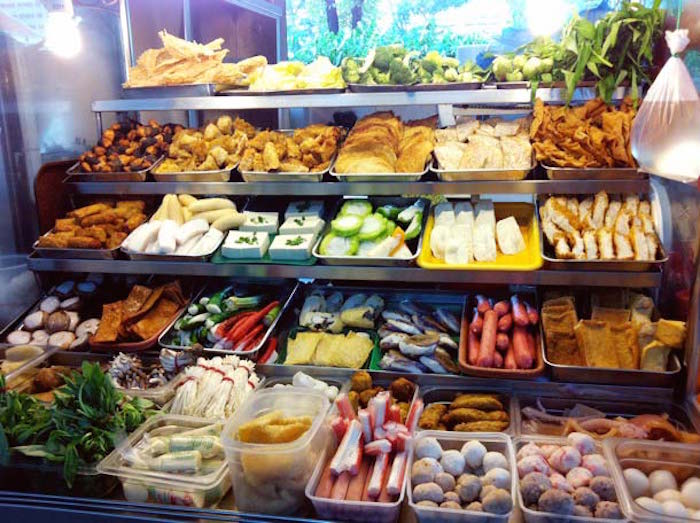
Photo courtesy of seriouseats.com
Yong tau foo is one of the healthier Singaporean foods. It is basically a dish in which you can choose your type of noodle or rice and your favorite ingredients (from various types of vegetables to various meat and fish products), which are enjoyed either in soup or “dry,”—that is, drizzled with sweet sauce and chili.
34. Ban Mian at China Whampoa Home Made Noodle
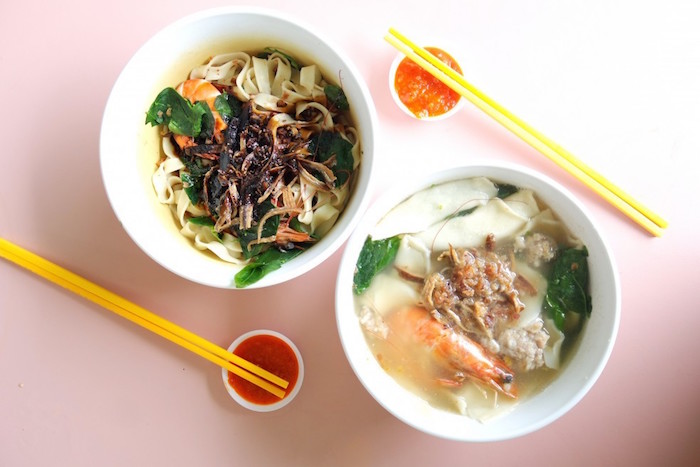
Photo courtesy of misstamchiak.com
Ban mian is a simple, healthy dish made of flat handmade egg noodles in a light, flavorful fish broth, accompanied with various ingredients such as leafy greens, fried ikan bilis (anchovy) and an egg that is cracked into the hot broth, mixed around and allowed to cooked till the whites are set and the yolk slightly firm.
35. Fish Head Steamboat at Whampoa Keng Fish Head Steamboat
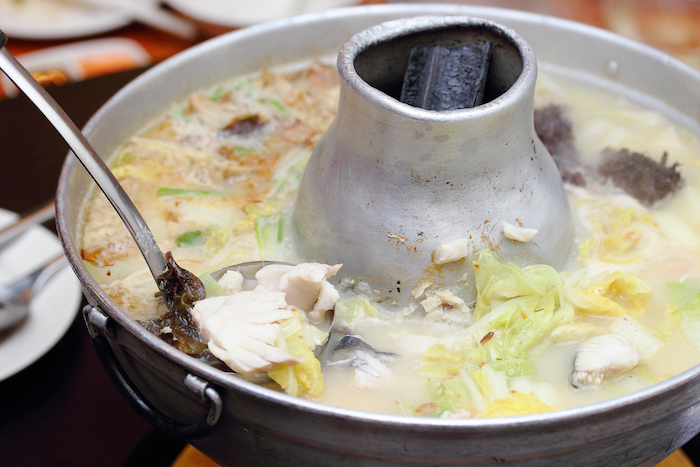
Photo courtesy of sgfoodonfoot.com
Steamboat is something Singaporeans hold dearly to their hearts. It’s traditionally eaten during reunion dinners, or even just during a casual bonding session with friends and family.
Typically, boiling fish head and fish bones for long periods of time results in a sweeter broth. The broth here contains fried yams, sour plums and vegetables, resulting in a quite distinct flavor as compared to other types of steamboats that commonly use either pork bones or chicken bones. Using old-school hot charcoal as a heat source also adds a smokier flavor, as compared to using an electric stove.
36. Curry Fish Head at Karu’s Indian Banana Leaf Restaurant
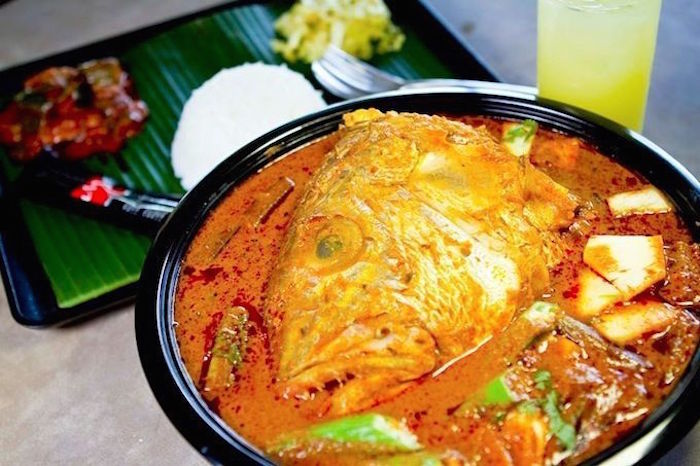
Photo courtesy of citynomads.com
Curry fish head is a bubbling cauldron of stewed fish head and fish meat in curry with assorted vegetables. It might be a scary dish the first time you see it, but this dish is quite a gastronomic heaven that boasts really complex flavors. If you’re adventurous enough, go ahead and eat those gelatinous eyes.
37. Kway Chap at Blanco Court Kway Chap
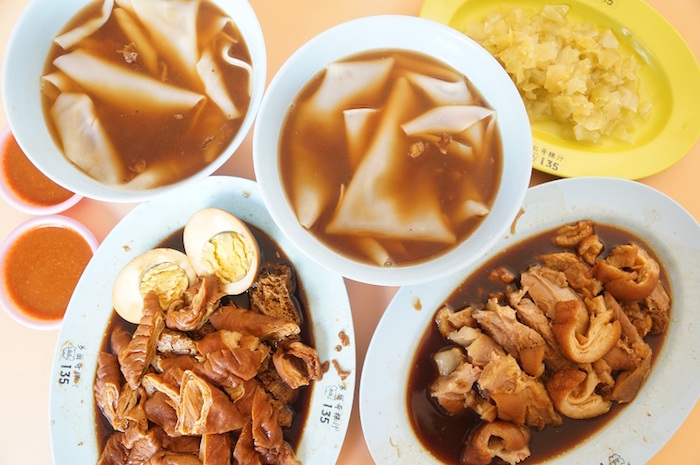
Photo courtesy of ieatandeat.com
Kway chap is a Teochew dish consisting of flat, broad rice noodles in a light soy sauce broth, served with a freely customizable set of assorted items such as pig innards, pork belly, duck meat, hard-boiled eggs and crispy tau pok, all braised in a dark, aromatic gravy.
Granted, most people would grimace at the thought of eating unwanted pig offal. However, the best kway chap stalls take it upon themselves to conduct a thorough colonoscopy after the intestines are disinfected by hand. The innards, properly cleaned and cooked perfectly, are resultantly tender and absent from smell, making this an interesting must-try dish here in Singapore.
38. Roasts at Kay Lee Roast Meat Joint
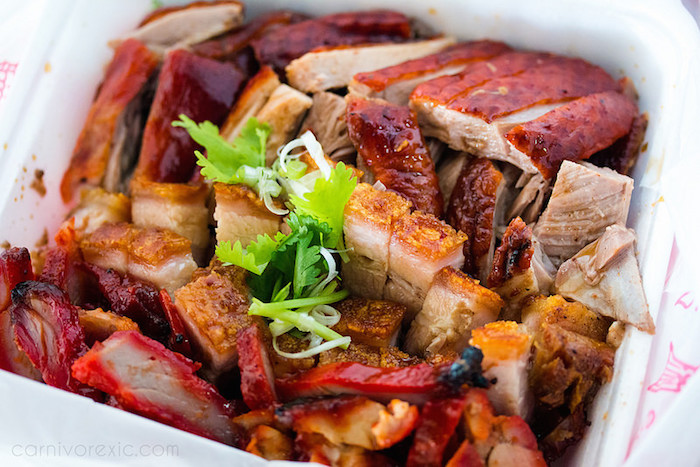
Photo courtesy of carnivorexic.com
Roasts basically refer to dishes of fatty roasted pork belly with a crispy skin, thick cuts of glazed, tender char siew, and juicy, succulent roast duck. A healthy dose of sweet, dark hoisin sauce is served on the side or drizzled on top.
Just two years ago, our favorite Kay Lee Roast Meat was sold for a jaw-dropping sum of $4 million to a loyal customer looking to expand the business. This $4 million deal included $2 million just for the treasured recipe. Yes, this delicious roast meat recipe is worth $2 million. Definitely a must try.
39. BBQ Sambal Stingray at Chomp Chomp Food Centre
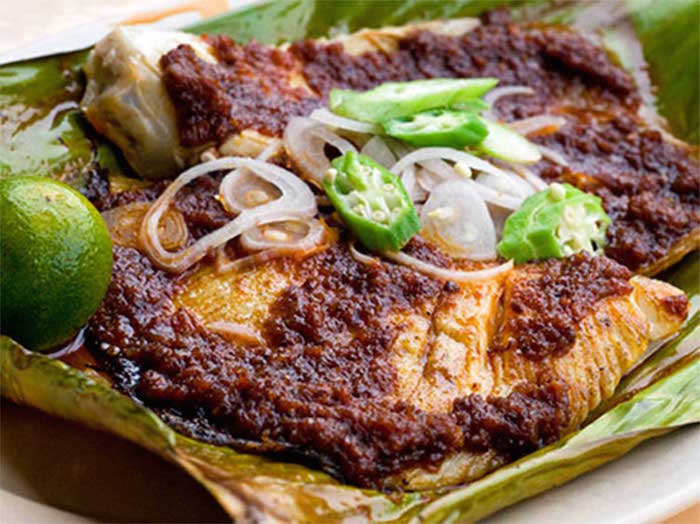
Photo courtesy of fongeeprimefoods.com
Stingray used to be an unpopular fish due to its fishy odor, but I guess Singaporeans found out that spicy sambal paste smothered generously on top of the stingray, and then barbecued in banana leaves, resulted in a smoky, sweet and tender flesh. Savor with a generous squeeze of lime and you’ll be assured a symphony of flavors in your mouth.
The best part? There are no tiny bones to worry about.
40. Chilli/Pepper Crab at Chin Huat Live Seafood
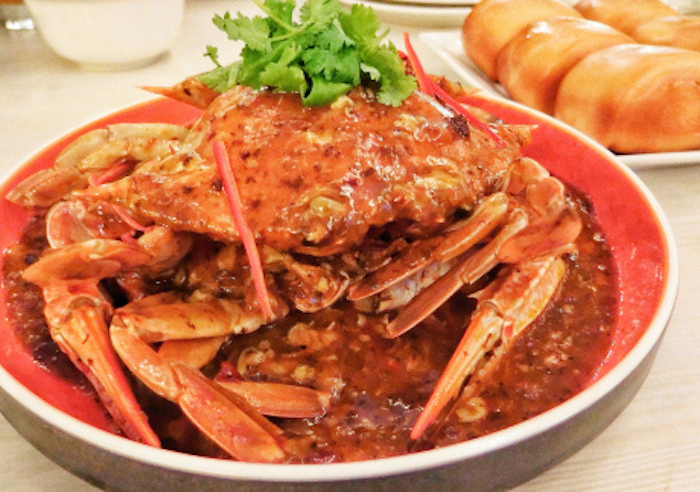
Photo by Elisa Djuhar
Chilli crab is what many Singaporeans consider as Singapore’s national dish. The crab is cooked in a slightly sweet, spicy thick gravy made from a tomato chili base, onions, garlic, ketchup and eggs. The black pepper crab, on the other hand, is fried with black pepper, has a dry consistency and boasts a pungent fiery aroma.
Go ahead and indulge in the majestic platters of crab with your bare hands, and don’t be afraid to lick that delicious sauce right off your fingers. Be sure to wear some kind of bib because cracking the shells will send sauce flying in every direction.
41. Milo Dinosaur at Toast Box
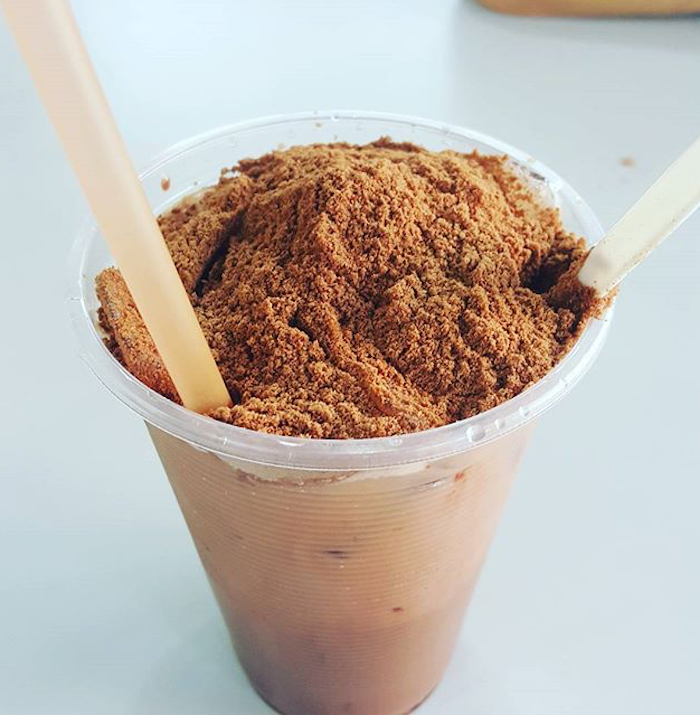
Photo by Elisa Djuhar
Milo is a chocolate-flavored drink made from dissolving Milo powder in water and sweetened condensed milk. As if that was not enough chocolate and sweetness, Milo dinosaur is basically a cold cup of Milo topped with spoonfuls of Milo powder. And then there’s Milo Godzilla — Milo Dinosaur topped with ice cream, which is indeed the ultimate indulgence and perfect drink for the sweltering weather in Singapore.
42. Teh Tarik at a local Kopitiam

Photo courtesy of ieatishootipost.sg
Teh tarik literally translates to “pulled tea” in Malay — its name is derived from the pouring processing of “pulling” the drink during preparation. The mixture of black tea and condensed milk is repeatedly poured back and forth through the air between two vessels until it reaches a rich, frothy texture.
This process cools the drink and thoroughly mixes it to bring out the full flavor of the tea. To be able to pour a proper cup of teh tarik from the right height without spilling a single drop requires years to master and is a distinguished characteristic of a skilled teh tarik artist.
43. Ang Ku Kueh at Ji Xiang Ang Ku Kueh
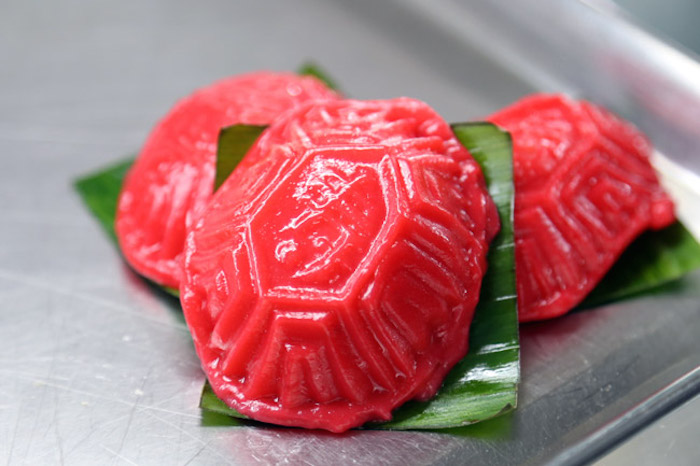
Photo courtesy of danielfooddiary.com
Ang ku kueh is a traditional Chinese pastry with a thin, tender and chewy skin made of glutinous rice flour that’s filled with sweet peanut paste or a bean paste made with split beans and salty green beans. It is traditionally red in color and molded in a shape of a tortoise, thus giving it its name which translates literally to “red tortoise cake.”
44. Tau Huay at Rochor Original Beancurd
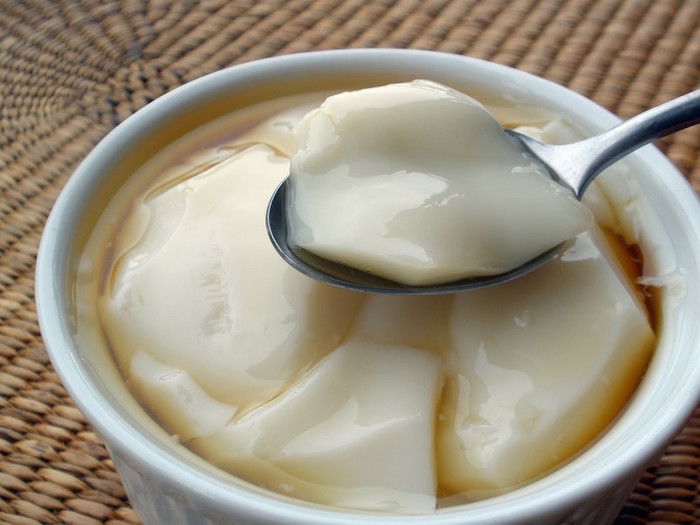
Photo courtesy of bakingquinn.blogspot.co.uk
Tau huay is a traditional Chinese dessert made from fresh bean curd tofu that has the texture of a wobbly, delicate custard. Usually sweetened with sugar syrup and eaten cold, the silken soy gel matrix quivers on your plastic spoon and falls apart at the slightest pressure of the tongue. At Rochor Orginal Beancurd, the lines are never-ending, even late at night when people take away containers and containers of this amazing dessert.
45. Durian at Goodwood Park Hotel
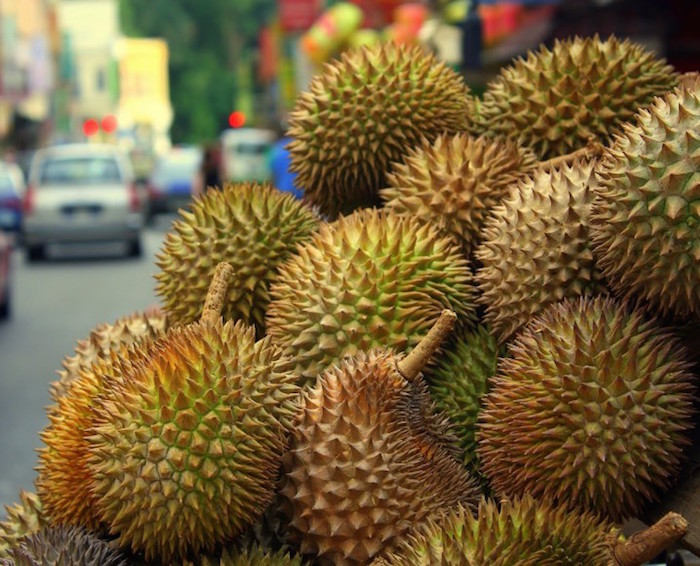
Photo courtesy of thechalkboardmag.com
Durian is (in)famously pungent — you either love it or hate it. It is banned in many public areas and, once eaten, you’ll have garlicky, strong-smelling breath that’ll remain with you for quite some time.
Durian is widely regarded as the “king of fruits” by many, and Singaporeans treat durian as a whole food group on its own. During the durian season, usually from June to August, it is eaten in its simple fruit form. During other months, however, Singaporeans love for the custardy durian flesh led them to create a whole range of desserts with it. This includes cakes, cream puffs, ice cream and even milkshakes.
46. Ice Kacang at Mei Heong Yuen
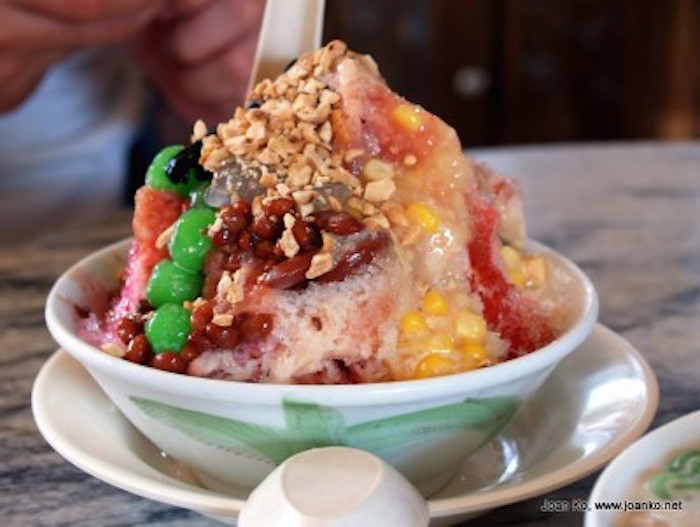
Photo courtesy of joanko.net
Ice kachang is one of the most popular desserts here in Singapore. It is made of shaved ice, toppings such as red beans, jelly, sweet corn and fruits, with a generous pour of flavored and colored syrups and condensed milk.
This is a thirst-quenching and refreshing concoction meant for Singaporeans to hydrate themselves in hot and sticky weather. Be sure to gobble it down fast, or you’ll end up with a bowl of unappetizing muddled toppings instead.
47. Cendol at Jin Jin Hot/Cold Dessert
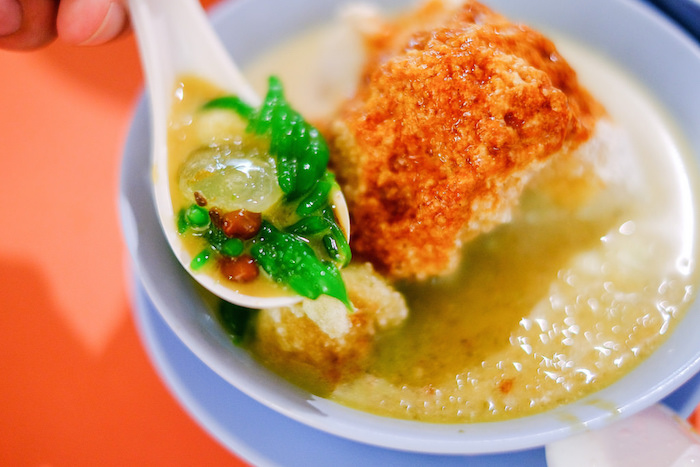
Photo courtesy of misstamchiak.com
Cendol is another popular local dessert, which also consists of shaved ice, this time accompanied with jelly noodles that have been flavored and dyed with pandan, drizzled with only gula melaka syrup, and served in a bowl of creamy coconut milk. What’s special is that the gula melaka syrup has a strong butterscotch flavor and retains its thick, fudge-like texture when diluted by the shaved ice.
48. Ondeh Ondeh at Cambridge Deli
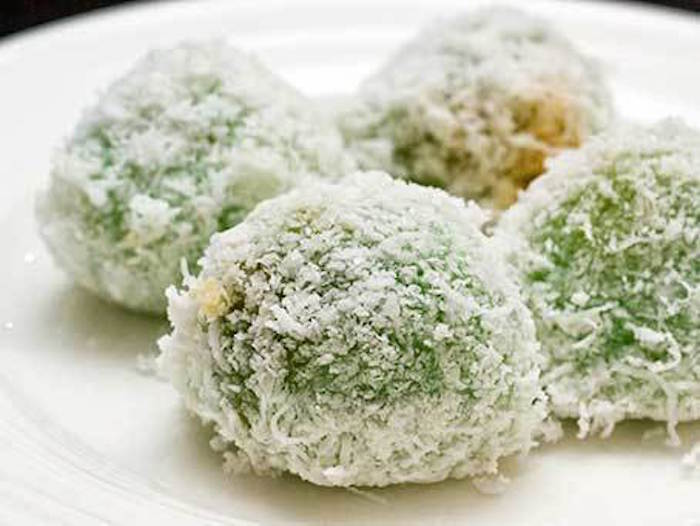
Photo courtesy of hungrygowhere.com
Ondeh ondeh is a chewy rice flour ball made with a combination of glutinous rice flour and tapioca flour that’s infused with pandan juice to give it a beautifully green color. It is coated with shredded coconut and filled with gula melaka that explodes in your mouth when you take a bite.
49. Mooncakes from TungLok Group Restaurants
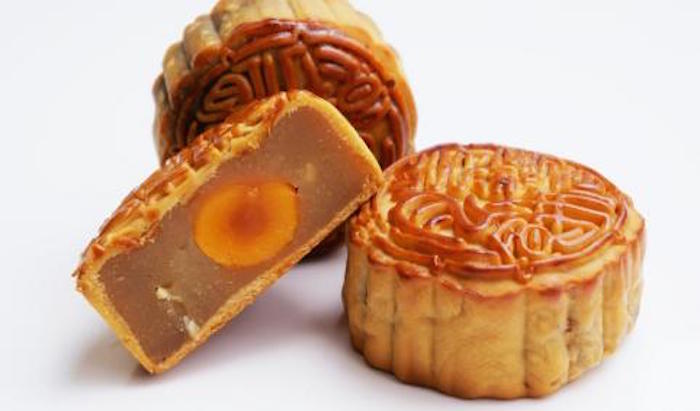
Photo courtesy of justinapexfitness.com
Mooncake is a Chinese baked pastry eaten during the Mid-Autumn Festival. Traditionally, there are mainly 3 different types of crust (chewy, flaky or tender), and the filling is usually sweetened red bean paste or lotus seed paste. Due to changing trends and preferences over time, both the crust and composition of the fillings have diversified to include contemporary versions.
50. Kueh Tutu at Tan’s Tu Tu Coconut Cakes
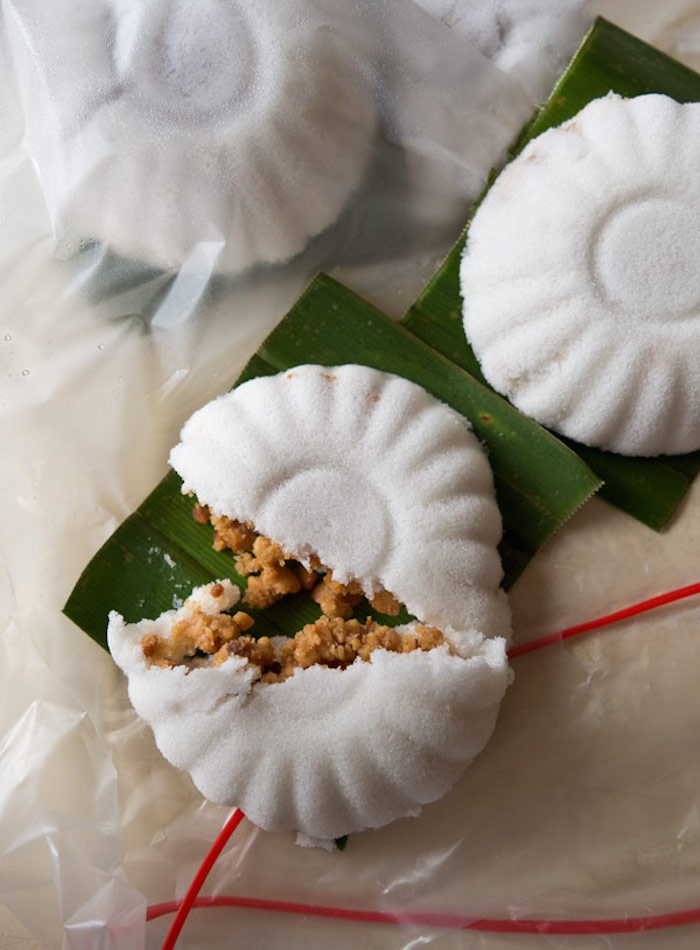
Photo courtesy of slowfood.sg
Kueh tutu is a delicate pastry made from rice flour and powdered sugar, filled with a sweetened peanut or coconut filling. It is rapidly steamed in a mold and served on pandan leaves for additional fragrance.
Given the waning popularity, the keuh tutu at Tan’s Tu Tu Coconut Cakes is definitely a must-try—the original owner was the first to popularize this delicious sweet snack back in the 1930s.


